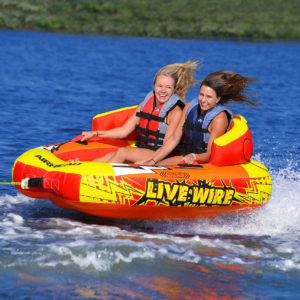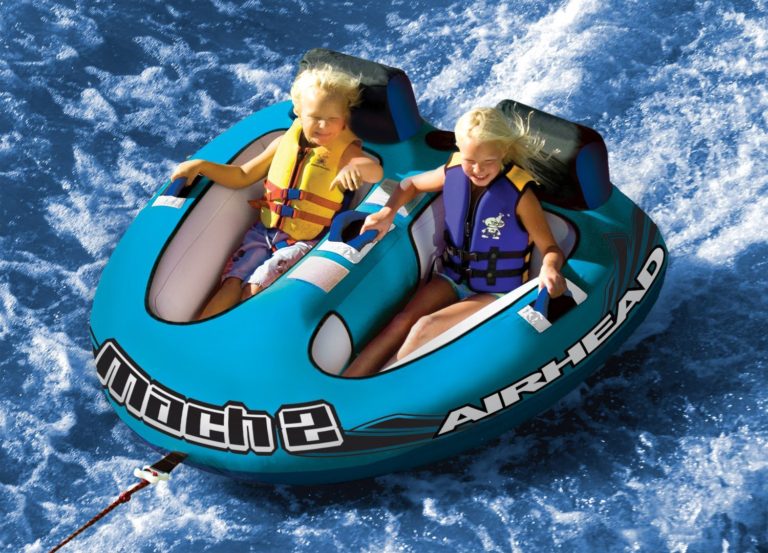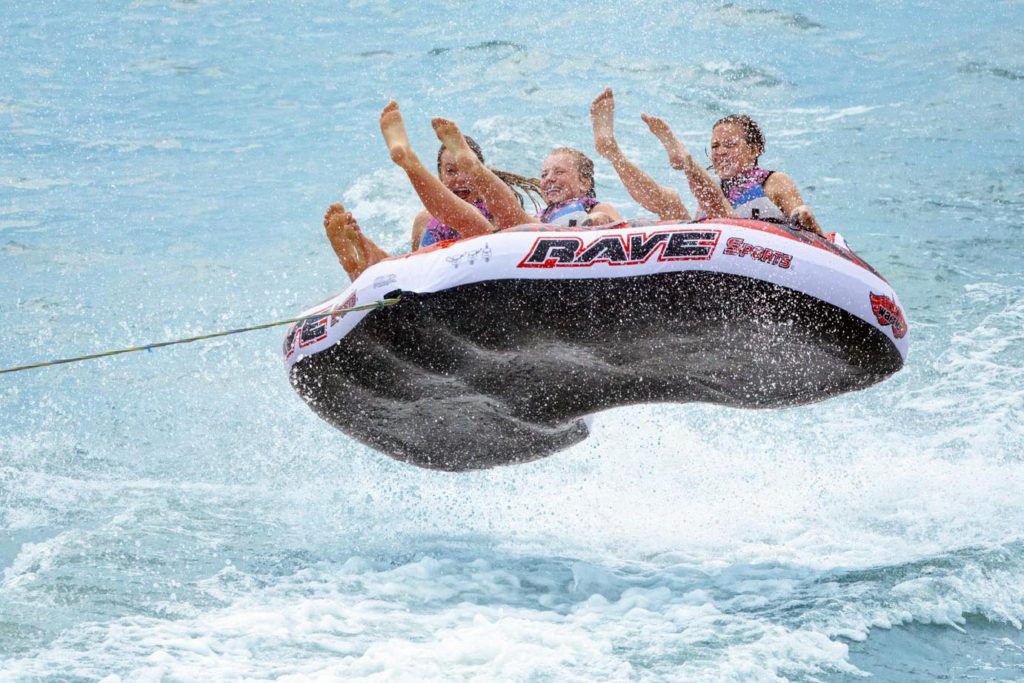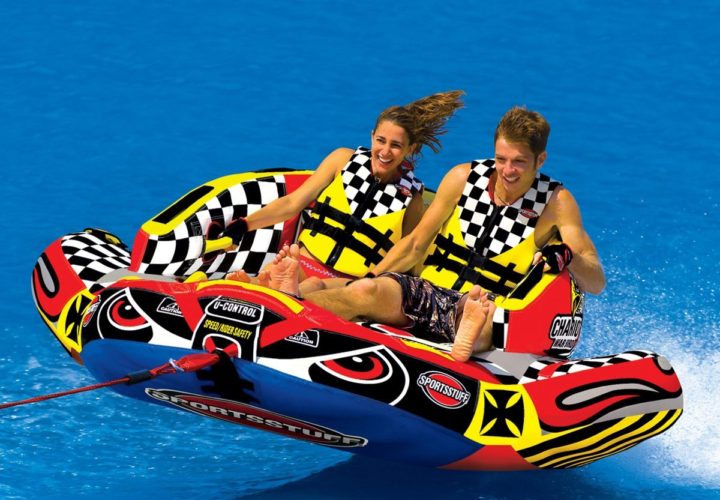If you have been anywhere near the water this summer, be it at a lake, river or ocean, you probably saw a boat towing a water skier, wakeboarder, skurfer or tuber. While 20 years ago tow toys were the domain of waterskis, times have changed.
First, we saw the advent of knee boards, then along came wakeboards and with it, the dominance of water skiing changed overnight. But not content with that, some bright manufacturer came up with the idea of taking the old tractor tire and replacing it with something a little more professional and so the sport of tubing was born.
But wait, why leave it just as a round inflatable tube, when there was so much more that could be added.
It didn’t take long before we started to see a wild variety of exotic tow toys, from flying wings to inflatable chairs. The big wings were great and got some huge air, but also could be quite dangerous. It was not unknown for them to rise over 10m and then come crashing down, dumping the occupants unceremoniously onto the hard water surface. Injuries were common and after some fatal accidents, the manufacturers stopped producing the flying wings.

Today there are some awesome inflatable tow toys available from single person tubes to three or four person towables in a variety of shapes, colours and styles.
They are constantly being updated with new models, designs, and radical colours. Most of the leading overseas brands are now available in this country and one, Loose Unit is a Kiwi product by Hutchwilco.
Finding the Right Towable
While towables come in many size and type of options, the first thing to decide is whether you want a performance orientated design or one for the family. There are tubes that are specifically designed to go very fast, for those that want a real adrenaline rush on the water and there are those that are family orientated and ideal for slow speed towing of kids.
The beauty is, that there are also plenty that fall in the middle and are suited to all uses. This way the young at heart get the action they want and the little kids are quite content being towed at a sedate and safe speed. These are more stable and easier to use than some of the performance towables.
They also require little skill to ride, which makes them suitable for families that intend to tow young children, multiple people, grandparents, or those who are looking for more relaxation and tamer rides.
It takes a bit more skill to ride a performance towable and you can do this kneeling, standing, sitting or laying down. They are designed to seriously catch some air, so the ability to stay on and land the right way up is critical. Hanging on in turns can be an awesome experience….especially when you get flung off. Cool fun!
The most common performance towables come in a wedge or delta – shaped design which allows riders to shift their weight to roll the wedge-shaped towables on edge to cut across or jump over waves.

Tubes are made of a variety of materials; PVC Vinyl, Polyester and Neoprene. They can vary in the thickness of denier, so it pays to ensure what you are buying is of sufficient quality and strength to survive your intended use. In other words, while a tube towing a couple of small kids will stand up to just about anything at low speeds, it may not be so good when you thrash it at high speeds with a couple of overweight weight adults aboard.
Different Shapes
The most common shape of a towable is the round doughnut, which is a modern version of the old tractor tube, with a fancy covering. They are inexpensive and ideal for a single adult.
Then there are the deck tubes which differ from the round doughnut as they don’t have a hole in the middle and are available in various shapes. They can be big enough for 3-4 riders and can be a great challenge to hang onto without tipping in turns.
With all the different styles now on the market laying down or sitting on a tube wasn’t enough for some, so we also have what they call the ride-in and the ride-on towables.

The ride-in as the name suggests is a tube that has seats and again you can get them for 1-4 people. They are reasonably dry and stable to ride and a favoured option with small children.
The ride-on is often called a banana boat and it’s where 6-8 people (or more) sit straddled over a torpedo or banana shaped tube. These are very popular with commercial operators at beach resorts.
At the more radical end of the tube design spectrum is those that feature massive rocker shapes. These either have a continuous rocker that flows evenly from one side to the other, or what is called a the 3-stage which has turned up wings on each side and a flat area which the riders lay or sit on. Riding these is strictly for the more experienced tuber.
As well as the ones already mentioned there are tubes that you lay inside. Again these are not for the faint-hearted and take some real skill to master.
A tow rope is a basic necessity of all towables and is specifically designed with higher break strengths and less stretch than a standard water ski rope. Single-person towables need about 900 kg rope, two-person towables need 1800 kg, and three or more need 2700 kg. Any tube rope should be a minimum of 15m in length and should not exceed 20m.
Finally, it is also important that you wear the correct buoyancy vest while on a towable.
Top Ten Safety Tips for Drivers and Riders
Courtesy of Rave Sports
According to accident reports from the U.S. Coast Guard, tubing is the towed water sports activity with the most injuries in recent years.
It is important for both boat drivers and inflatable riders to understand that the sport can cause serious injury or death and to use common sense and good judgment at all times. However, tubing can provide a lot of fun and entertainment when practised with these safety tips in mind:
1) Be aware that inflatables are not steerable by passengers and that the driver is responsible for the safety of the rider(s). Inflatables travel at a wider arch and greater speeds during turns than the boat travels, so the driver and spotter should be mindful of the towable’s trajectory at all times.
For example, if the boat speed is 20 mph, an inflatable can reach speeds up to 55 mph during a sharp turn (commonly called a “whip”). Contact during a whip with other boats, shoreline, shallow water, or other fixed objects such as docks can cause serious injury or death.
2) Do not mix driving a boat or participating in water sports with alcohol, drugs or any substance that can impair your judgment and always follow warning labels on inflatables and guidelines in your boat owner’s manual. Also, become knowledgeable about the area you will be towing and be aware of any obstacles, shallow water, and wake and or speed restrictions before you start out.

3) Riders should always wear a life jacket and make sure it is in good condition, fits properly, and is not worn out.
4) Inspect the inflation level of your towable and be aware that temperature fluctuations can cause changes in the firmness of inflatable towables.
5) Check your tow rope’s strength to be sure it is appropriate for the number of riders in your inflatable and that the rope does not have knots, frayed edges, or sun damage; affix tow rope only to the boat manufacturer’s recommended attachment point on your boat.
6) The driver should use a rear view mirror and always have a spotter in the boat so the driver can focus on looking in front of the boat, not behind; both must always be aware of other boaters and fixed objects such as docks, swim platforms, and buoys.
7) Discuss hand signals with the rider before the ride and have the spotter communicate the rider’s signals to the driver during the ride:
— OK (tip of index finger and thumb together)
— Faster (thumb up)
— Slower (thumb down)
— Stop (hand slashing neck)
— Turn around (index finger pointed up and going around in a circle)
— Back to shore or dock (Pat top of head)
8) Check for rope entanglements and gently pull slack out of the rope before increasing throttle speed; wait until rider(s) indicate readiness and is/are free from rope entanglements (it is common to instruct riders to yell “hit it!” when they are ready).

9) Boat speeds should not exceed 20 mph and should be appropriate for the experience of the rider(s). Riders should also know their limits and communicate them with the driver before and during the ride. Also, large waves and wakes should be avoided to keep the inflatable on the water, not in the air. When tubes become airborne, the safety of the rider(s) becomes jeopardised and can result in severe injury to the muscles, spine, internal organs due to collisions with other riders or falling off the tube.
10) Injuries also occur when elbows, knees, and heads of riders collide with other riders, so passengers should always stay put and avoid horseplay or moving around. It is also dangerous to pull more than one inflatable at a time or with other towables such as water skiers or wakeboarders.
Above all, safety should always be the priority with all water sports, but especially when water tubing. Review these safety tips before you head out on the water, as everyone will have more fun when they are tubing safely.




